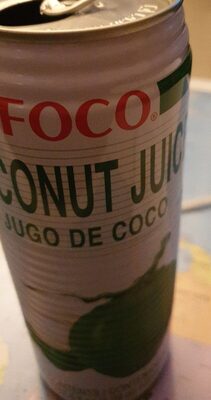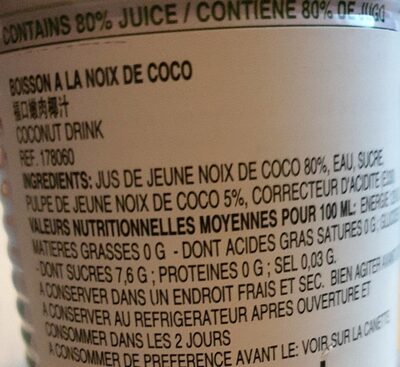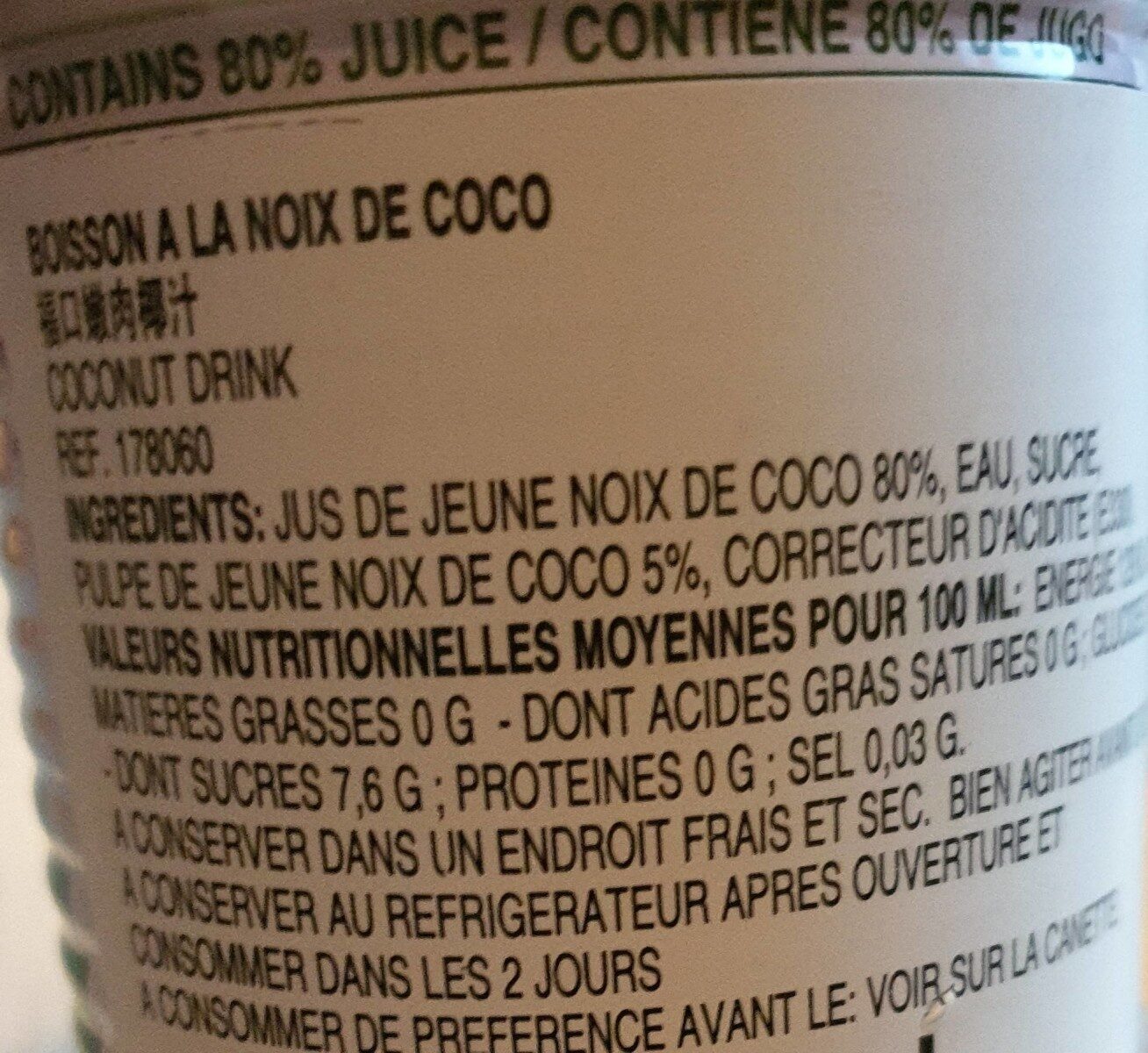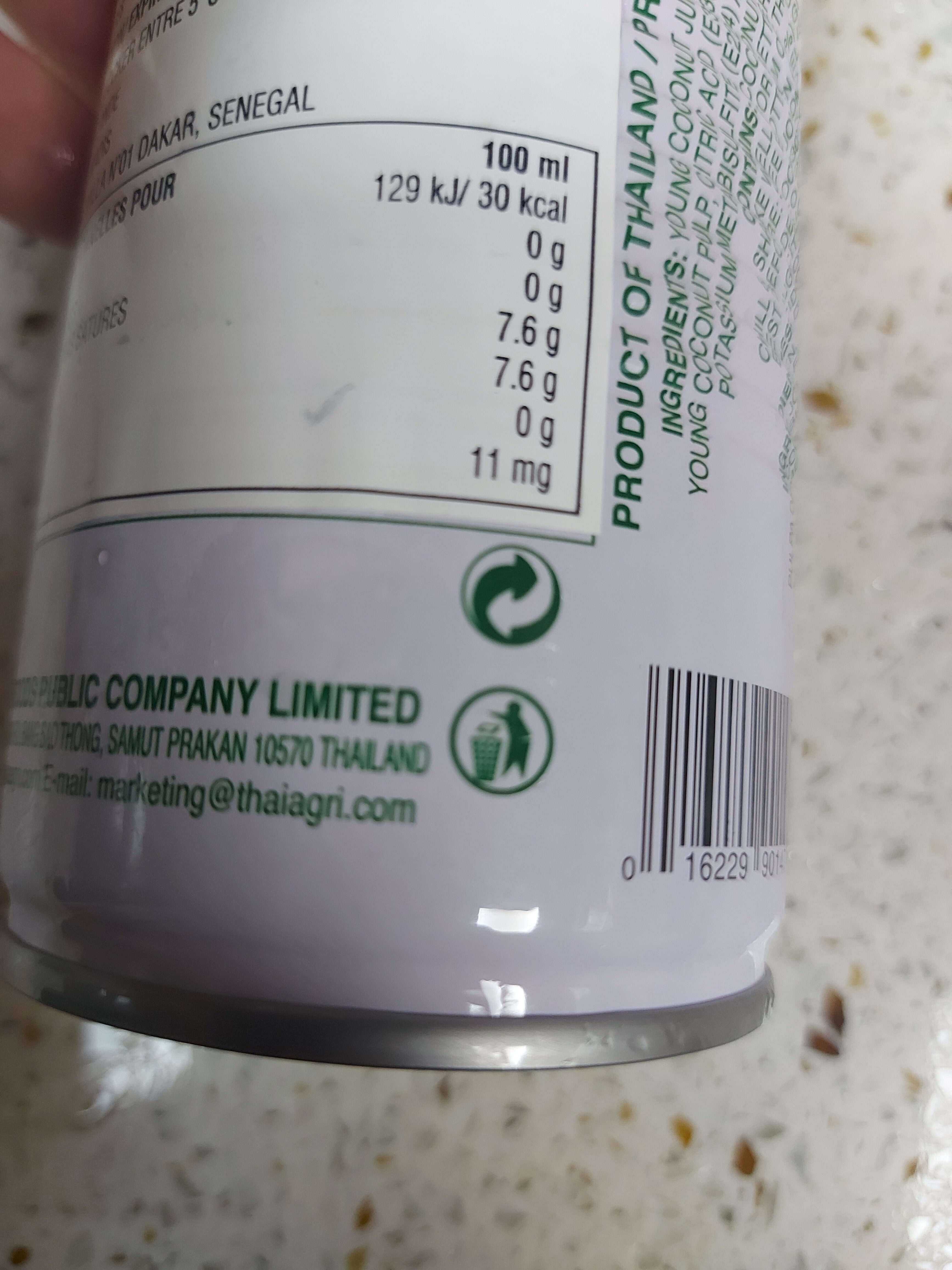Help us make food transparency the norm!
As a non-profit organization, we depend on your donations to continue informing consumers around the world about what they eat.
The food revolution starts with you!
Cocontractant juice - foco - 520 ml
Cocontractant juice - foco - 520 ml
Barcode: 0016229901479 (EAN / EAN-13) 016229901479 (UPC / UPC-A)
Quantity: 520 ml
Packaging: Metal, Recyclable Metals, Aluminium
Brands: Foco, Thai Agri Foods Co. Ltd.
Brand owner: Thai Agri Foods Co., Ltd.
Categories: Plant-based foods and beverages, Beverages, Plant-based beverages, Fruit-based beverages, Juices and nectars, Fruit juices, fr:Jus de coco
Origin of ingredients: Thailand
Countries where sold: France, United States
Matching with your preferences
Health
Ingredients
-
7 ingredients
young coconut (80%), water, sugar, citric acid (e330) as acidity regulations, potassium metabsulphaite(e224) as preservative
Food processing
-
Food processing level unknown
Food products are classified into 4 groups according to their degree of processing:
- Unprocessed or minimally processed foods
- Processed culinary ingredients
- Processed foods
- Ultra processed foods
The determination of the group is based on the category of the product and on the ingredients it contains.
Additives
-
E224 - Potassium metabisulphite
Potassium metabisulfite: Potassium metabisulfite, K2S2O5, also known as potassium pyrosulfite, is a white crystalline powder with a pungent sulfur odour. The main use for the chemical is as an antioxidant or chemical sterilant. It is a disulfite and is chemically very similar to sodium metabisulfite, with which it is sometimes used interchangeably. Potassium metabisulfite is generally preferred out of the two as it does not contribute sodium to the diet. Potassium metabisulfite has a monoclinic crystal structure which decomposes at 190 °C, yielding potassium sulfite and sulfur dioxide: K2S2O5-s- → K2SO3-s- + SO2-g-Source: Wikipedia
-
E330 - Citric acid
Citric acid is a natural organic acid found in citrus fruits such as lemons, oranges, and limes.
It is widely used in the food industry as a flavor enhancer, acidulant, and preservative due to its tart and refreshing taste.
Citric acid is safe for consumption when used in moderation and is considered a generally recognized as safe (GRAS) food additive by regulatory agencies worldwide.
Ingredients analysis
-
Palm oil content unknown
Unrecognized ingredients: fr:jus-de-jeune-noix-de-coco, fr:sucre-pulpe-de-jeune-noix-de-coco, fr:comme-regulateur-d-acidite, E224-comme-conservateurSome ingredients could not be recognized.
We need your help!
You can help us recognize more ingredients and better analyze the list of ingredients for this product and others:
- Edit this product page to correct spelling mistakes in the ingredients list, and/or to remove ingredients in other languages and sentences that are not related to the ingredients.
- Add new entries, synonyms or translations to our multilingual lists of ingredients, ingredient processing methods, and labels.
If you would like to help, join the #ingredients channel on our Slack discussion space and/or learn about ingredients analysis on our wiki. Thank you!
-
Vegan status unknown
Unrecognized ingredients: fr:jus-de-jeune-noix-de-coco, fr:sucre-pulpe-de-jeune-noix-de-coco, fr:comme-regulateur-d-acidite, E224-comme-conservateurSome ingredients could not be recognized.
We need your help!
You can help us recognize more ingredients and better analyze the list of ingredients for this product and others:
- Edit this product page to correct spelling mistakes in the ingredients list, and/or to remove ingredients in other languages and sentences that are not related to the ingredients.
- Add new entries, synonyms or translations to our multilingual lists of ingredients, ingredient processing methods, and labels.
If you would like to help, join the #ingredients channel on our Slack discussion space and/or learn about ingredients analysis on our wiki. Thank you!
-
Vegetarian status unknown
Unrecognized ingredients: fr:jus-de-jeune-noix-de-coco, fr:sucre-pulpe-de-jeune-noix-de-coco, fr:comme-regulateur-d-acidite, E224-comme-conservateurSome ingredients could not be recognized.
We need your help!
You can help us recognize more ingredients and better analyze the list of ingredients for this product and others:
- Edit this product page to correct spelling mistakes in the ingredients list, and/or to remove ingredients in other languages and sentences that are not related to the ingredients.
- Add new entries, synonyms or translations to our multilingual lists of ingredients, ingredient processing methods, and labels.
If you would like to help, join the #ingredients channel on our Slack discussion space and/or learn about ingredients analysis on our wiki. Thank you!
-
Details of the analysis of the ingredients
We need your help!
Some ingredients could not be recognized.
We need your help!
You can help us recognize more ingredients and better analyze the list of ingredients for this product and others:
- Edit this product page to correct spelling mistakes in the ingredients list, and/or to remove ingredients in other languages and sentences that are not related to the ingredients.
- Add new entries, synonyms or translations to our multilingual lists of ingredients, ingredient processing methods, and labels.
If you would like to help, join the #ingredients channel on our Slack discussion space and/or learn about ingredients analysis on our wiki. Thank you!
: JUS DE JEUNE NOIX DE COCO 80%, EAU, SUCRE PULPE DE JEUNE NOIX DE COCO, ACIDE CITRIQUE (e330), COMME REGULATEUR D'ACIDITE, METABISULFITE DE POTASSIUM e224) COMME CONSERVATEUR- JUS DE JEUNE NOIX DE COCO -> fr:jus-de-jeune-noix-de-coco - percent_min: 80 - percent: 80 - percent_max: 80
- EAU -> en:water - vegan: yes - vegetarian: yes - ciqual_food_code: 18066 - percent_min: 4 - percent_max: 20
- SUCRE PULPE DE JEUNE NOIX DE COCO -> fr:sucre-pulpe-de-jeune-noix-de-coco - percent_min: 0 - percent_max: 16
- ACIDE CITRIQUE -> en:e330 - vegan: yes - vegetarian: yes - percent_min: 0 - percent_max: 8
- e330 -> en:e330 - vegan: yes - vegetarian: yes - percent_min: 0 - percent_max: 8
- COMME REGULATEUR D'ACIDITE -> fr:comme-regulateur-d-acidite - percent_min: 0 - percent_max: 5.33333333333333
- METABISULFITE DE POTASSIUM e224) COMME CONSERVATEUR -> en:e224-comme-conservateur - percent_min: 0 - percent_max: 4
Nutrition
-
Bad nutritional quality
⚠ ️Warning: the amount of fruits, vegetables and nuts is not specified on the label, it was estimated from the list of ingredients: 0This product is considered a beverage for the calculation of the Nutri-Score.
Positive points: 0
- Proteins: 0 / 5 (value: 0, rounded value: 0)
- Fiber: 0 / 5 (value: 0, rounded value: 0)
- Fruits, vegetables, nuts, and colza/walnut/olive oils: 0 / 10 (value: 0, rounded value: 0)
Negative points: 11
- Energy: 5 / 10 (value: 129, rounded value: 129)
- Sugars: 6 / 10 (value: 7.6, rounded value: 7.6)
- Saturated fat: 0 / 10 (value: 0, rounded value: 0)
- Sodium: 0 / 10 (value: 12, rounded value: 12)
The points for proteins are not counted because the negative points are greater or equal to 11.
Nutritional score: (11 - 0)
Nutri-Score:
-
Nutrient levels
-
Fat in low quantity (0%)
What you need to know- A high consumption of fat, especially saturated fats, can raise cholesterol, which increases the risk of heart diseases.
Recommendation: Limit the consumption of fat and saturated fat- Choose products with lower fat and saturated fat content.
-
Saturated fat in low quantity (0%)
What you need to know- A high consumption of fat, especially saturated fats, can raise cholesterol, which increases the risk of heart diseases.
Recommendation: Limit the consumption of fat and saturated fat- Choose products with lower fat and saturated fat content.
-
Sugars in high quantity (7.6%)
What you need to know- A high consumption of sugar can cause weight gain and tooth decay. It also augments the risk of type 2 diabetes and cardio-vascular diseases.
Recommendation: Limit the consumption of sugar and sugary drinks- Sugary drinks (such as sodas, fruit beverages, and fruit juices and nectars) should be limited as much as possible (no more than 1 glass a day).
- Choose products with lower sugar content and reduce the consumption of products with added sugars.
-
Salt in low quantity (0.03%)
What you need to know- A high consumption of salt (or sodium) can cause raised blood pressure, which can increase the risk of heart disease and stroke.
- Many people who have high blood pressure do not know it, as there are often no symptoms.
- Most people consume too much salt (on average 9 to 12 grams per day), around twice the recommended maximum level of intake.
Recommendation: Limit the consumption of salt and salted food- Reduce the quantity of salt used when cooking, and don't salt again at the table.
- Limit the consumption of salty snacks and choose products with lower salt content.
-
-
Nutrition facts
Nutrition facts As sold
for 100 g / 100 mlAs sold
per serving (240ml)Compared to: Fruit juices Energy 129 kj
(30 kcal)310 kj
(72 kcal)-35% Energy from fat 21 kj
(5 kcal)50.4 kj
(12 kcal)+950% Fat 0 g 0 g Saturated fat 0 g 0 g Trans fat 0 g 0 g Cholesterol 0 mg 0 mg Salt 0.03 g 0.072 g +88% Carbohydrates 7.6 g 18.2 g -34% Fiber 0 g 0 g -100% Sugars 7.6 g 18.2 g -28% Proteins 0 g 0 g -100% Vitamin A 0 µg 0 µg -100% Vitamin C (ascorbic acid) 0 mg 0 mg -100% Calcium 25 mg 60 mg +61% Iron 0.23 mg 0.552 mg +69% Fruits‚ vegetables‚ nuts and rapeseed‚ walnut and olive oils (estimate from ingredients list analysis) 0 % 0 %
Environment
-
Eco-Score E - Very high environmental impact
The Eco-Score is an experimental score that summarizes the environmental impacts of food products.→ The Eco-Score was initially developped for France and it is being extended to other European countries. The Eco-Score formula is subject to change as it is regularly improved to make it more precise and better suited to each country.Life cycle analysis
-
Average impact of products of the same category: D (Score: 24/100)
Category: Mixed fruits juice, pure juice
Category: Mixed fruits juice, pure juice
- PEF environmental score: 0.32 (the lower the score, the lower the impact)
- including impact on climate change: 0.91 kg CO2 eq/kg of product
Stage Impact Agriculture
80.8 %Processing
1.8 %Packaging
4.5 %Transportation
9.3 %Distribution
2.8 %Consumption
0.8 %
Bonuses and maluses
-
Origins of ingredients with a high impact
Malus: -5
Environmental policy: -5
Transportation: 0
Origin of the product and/or its ingredients % of ingredients Impact Thailand 100 %High
-
Packaging with a low impact
Malus: -3
Shape Material Recycling Impact Unknown Heavy aluminium Medium ⚠ ️ The information about the packaging of this product is not sufficiently precise (exact shapes and materials of all components of the packaging).⚠ ️ For a more precise calculation of the Eco-Score, you can modify the product page and add them.
If you are the manufacturer of this product, you can send us the information with our free platform for producers.
Eco-Score for this product
-
Impact for this product: E (Score: 16/100)
Product: Cocontractant juice - foco - 520 ml
Life cycle analysis score: 24
Sum of bonuses and maluses: -8
Final score: 16/100
-
Carbon footprint
-
Equal to driving 0.5 km in a petrol car
91 g CO² per 100g of product
The carbon emission figure comes from ADEME's Agribalyse database, for the category: Mixed fruits juice, pure juice (Source: ADEME Agribalyse Database)
Stage Impact Agriculture
34.1 %Processing
9.7 %Packaging
16.3 %Transportation
35.3 %Distribution
3.9 %Consumption
0.7 %
Packaging
-
Packaging with a low impact
-
Packaging parts
(Aluminium)
-
Packaging materials
Material % Packaging weight Packaging weight per 100 g of product Metal
-
Transportation
-
Origins of ingredients
Origins of ingredients with a high impact
Origin of the product and/or its ingredients % of ingredients Impact Thailand 100 %High
Report a problem
-
Incomplete or incorrect information?
Category, labels, ingredients, allergens, nutritional information, photos etc.
If the information does not match the information on the packaging, please complete or correct it. Open Food Facts is a collaborative database, and every contribution is useful for all.
Data sources
Product added on by openfoodfacts-contributors
Last edit of product page on by ninehadi.
Product page also edited by autorotate-bot, ecoscore-impact-estimator, inf, kiliweb, org-database-usda, tacite, usda-ndb-import, yuka.N-BwB9-zR5AcM8XxzJAM2ialCcPAL-Z4HHxdog, yuka.U3ZvRFN2UVEvUFFZeHNJbTVCbmZ4TU5VMWJTSGVGeTRKZElMSVE9PQ, yuka.V2JGZFFQNC92T0ZVcThFNjBqWDgwZlZ0L0xtamJEcU1EYzVKSVE9PQ, yuka.sY2b0xO6T85zoF3NwEKvllFmUcfzqwDOHAP5mEHX7PHWf5rMeO9z8I_DI6s, yukafix.












